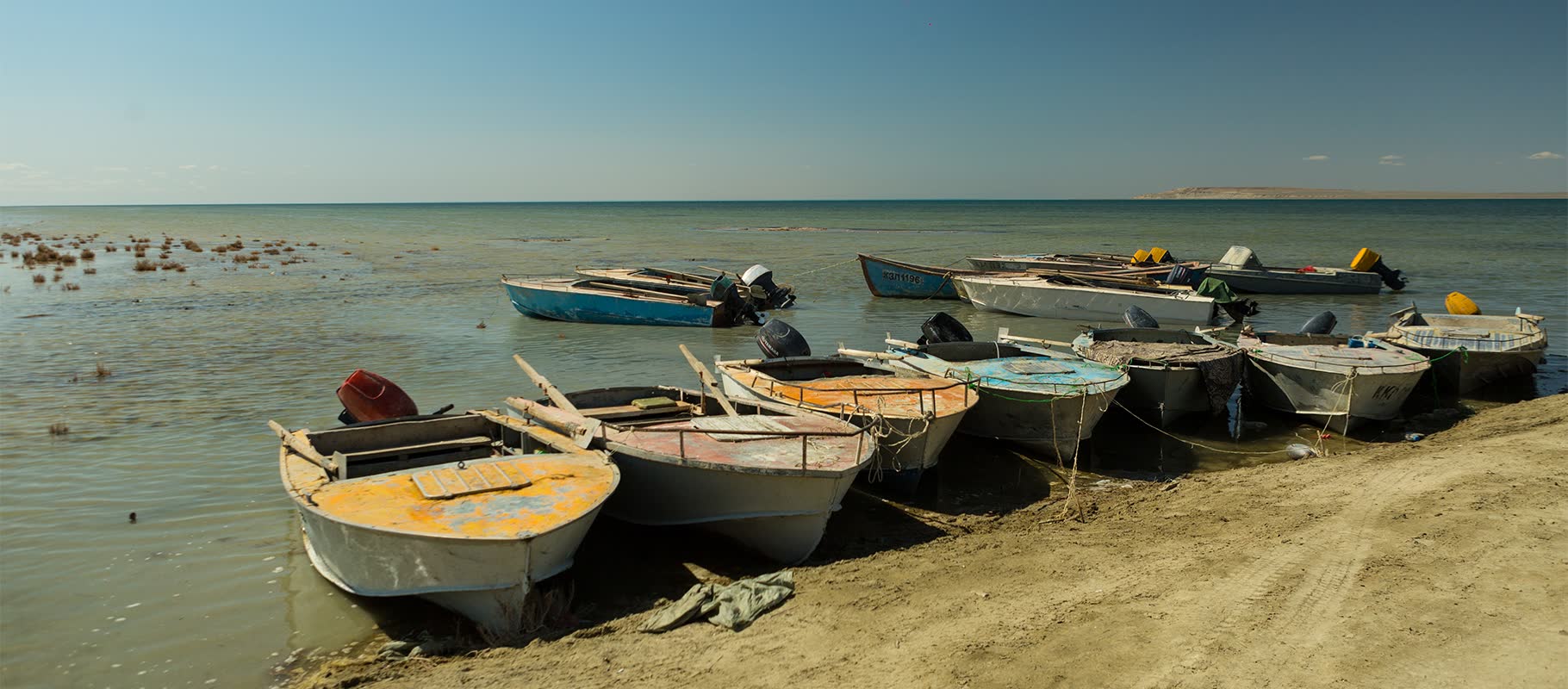Aral Sea
The Aral Sea, once one of the world's largest inland bodies of water, is located in Central Asia, spanning the borders of Kazakhstan and Uzbekistan. Historically, it was known for its abundant fish stocks and its importance as a vital water source for the surrounding region. However, the Aral Sea has experienced a severe ecological and environmental crisis over the past few decades due to human activities.
🌊Aral Sea – A Vanishing Wonder of Central Asia
Consequences: The shrinking of the Aral Sea has had severe consequences, including the loss of livelihoods for local communities that relied on fishing, the exposure of previously submerged toxic chemicals on the exposed lakebed, and the creation of an inhospitable and dusty environment.
Split into Smaller Lakes: The original Aral Sea has effectively split into two smaller bodies of water: the North Aral Sea (located primarily in Kazakhstan) and the South Aral Sea (mostly in Uzbekistan). Efforts to stabilize and restore the North Aral Sea have seen some success, leading to increased water levels and the revival of fish populations in that part of the sea.
International Efforts: Various international organizations and countries, including the World Bank, the United Nations, and local governments, have been involved in efforts to address the Aral Sea crisis. These efforts aim to improve water management, reduce environmental damage, and restore the ecosystems surrounding the sea.
Environmental and Human Impact: The shrinking of the Aral Sea has caused a significant negative impact on the environment, health, and economy of the region. The exposed lakebed has become a source of dust storms, and the sea's salinity has increased, leading to further environmental degradation.
The Aral Sea serves as a prominent example of the environmental consequences of unsustainable water use and irrigation practices. Efforts to mitigate the crisis and restore the sea's ecological balance continue, but the ecological changes that have occurred are long-lasting and continue to affect the surrounding regions.

📍 Overview
The Aral Sea was once one of the largest inland seas on Earth, straddling the border between Kazakhstan and Uzbekistan. Once teeming with life and supporting fishing towns and rich ecosystems, it has become a stark symbol of environmental mismanagement. Over the past six decades, the sea has shrunk dramatically, transforming much of its former seabed into arid desert now known as the Aralkum.
Despite its decline, the Aral Sea remains a powerful destination for those interested in nature, history, photography, and environmental change.
🧭 Location & Geography
Region: Kyzylorda Region, southwestern Kazakhstan
Nearby Town: Aral (the former fishing port)
Original Size: ~68,000 square kilometers
Current State: Severely diminished, with the North Aral Sea partially restored
The sea is now split into two primary bodies:
North Aral Sea (Small Aral) in Kazakhstan
South Aral Sea (largely dried) in Uzbekistan
📜 History & Collapse
In the 1960s, the Soviet Union diverted the Amu Darya and Syr Darya rivers for large-scale cotton irrigation. As a result:
The Aral Sea began shrinking rapidly
By the 2000s, it had lost over 90% of its volume
The once-thriving fishing industry collapsed
Winds spread toxic salt and dust from the dry seabed, damaging health and agriculture
The disaster is often cited as one of the worst environmental catastrophes of the 20th century.
🌱 The North Aral Sea – A Story of Hope
Thanks to international cooperation and Kazakhstan’s efforts, a dam project (Kok-Aral Dam) completed in 2005 helped restore part of the sea.
Key improvements:
Water levels in the North Aral Sea rose
Fish returned, reviving local fishing industries
Communities like Aral saw signs of economic recovery
While the southern portion continues to dry, the North Aral Sea’s revival stands as a rare case of partial environmental recovery.
❓ Why Visit the Aral Sea?
1. Witness a Living Environmental Lesson
The dried seabed, rusting ships, and museum in Aral offer a real-world look at the impacts of human intervention in nature.
2. Explore Ghost Ports and Ship Graveyards
See abandoned fishing vessels lying in the sand — an eerie, photogenic symbol of what once was.
3. Visit the Aral Sea Museum in Aral
Gain insight into the sea’s past glory, collapse, and attempts at restoration.
4. Engage in Sustainable Tourism
Support local communities that are rebuilding eco-tourism, scientific study, and cultural preservation.
5. Combine with Desert & Cultural Tours
The nearby Aral Karakum Desert, Otyrar ruins, and Arystan Bab Mausoleum create a well-rounded regional experience.
📸 What to See & Do
🚢 Ship Graveyard in Zhalanash
🏛️ Aral Sea Museum in Aralsk
🧭 Drive across the dry seabed
🐟 Visit revived fish farms and local fishing cooperatives
📷 Take dramatic landscape photographs of salt flats, dunes, and wrecks
🚗 How to Get There
Nearest Major City: Kyzylorda
By Train: From Almaty or Astana to Aral
By Car: Off-road tours recommended; 4x4 vehicle required for desert terrain
Best Time to Visit: April to June and September to October (avoid extreme summer heat and winter cold)
📝 Final Thoughts
The Aral Sea is not just a place on a map — it’s a cautionary tale, a story of decline, and a testament to resilience and hope. For travelers, ecologists, and historians alike, it offers a raw and unforgettable experience in the heart of Kazakhstan’s vast steppes.
RELATED DESTINATIONS
Explore Otyrar’s ancient Silk Road ruins in Kazakhstan—rich in history, culture, and archaeology, a must-visit for history lovers and travelers.
Uncover Sauran Fortress in southern Kazakhstan—Silk Road stronghold with medieval ruins, ancient defenses, and rich Turkic cultural heritage.
Explore Sayram-Ugam National Park in southern Kazakhstan—mountain landscapes, diverse wildlife, hiking trails, and rich cultural heritage.


